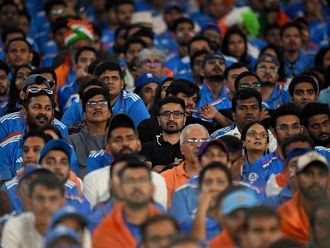Whatever happens in the next general elections — my bet is early 2013 — India will emerge an extremely divided country. The usual assumption that the two main political parties, the Congress and the Bharatiya Janata Party (BJP), will have between them a majority of seats look like going awry. Both have gone down so much in public estimate that neither of them may cross even the three-figure mark.
It is obvious that there will be parties of all religious and ideological stripes in the field this time. The vote is bound to be divided. A party which wins more than 50 seats can become a fulcrum and try to attract others. This will mean that quite a few parties will have to gather on one platform to garner 273 seats for a majority in the 546-member Lok Sabha, the lower house.
The Congress and the BJP have been mauled by charges of corruption — the BJP because of its president Nitin Gadkari’s fictitious companies and the Congress because of a series of scams topped with bogus land purchases by Congress president Sonia Gandhi’s son-in-law, Robert Vadhra. The worse is the arrogance of the two parties which is shown in their contempt for the people demanding an independent inquiry.
Allegations of corruption will chase the Congress in its electoral campaigns. Prime Minister Manmohan Singh, a cleaner person, may not escape the slings when the scams could have been nipped in the bud if the Prime Minister’s Office had acted. In fact, its connivance, if not complicity, has been a common feature of scams.
The Union Cabinet reshuffle cannot revive hope when the general impression is that the Congress has become a den of corruption. Most in the cabinet are neither clean nor competent and when a comparatively honest minister, Jaipal Reddy, is removed from the Petroleum Ministry, it is confirmed that the Congress is helpless before the corporate sector in view of money it amasses for elections.
In comparison, the BJP is less guilty, simply because it has not been in power for more than eight years. The states, particularly Karnataka and Madhya Pradesh, have brought the party a bad name. Yet, corruption in the BJP-run states may not get so much importance as the government of India’s scams which will become the topic in the next general elections.
The slight advantage for Congress will be outweighed by the communalism factor of the BJP. The party is too parochial and too much linked with the RSS, the mother of all communal hatred. The way in which the BJP went back to support Gadkari once the RSS backed him proves once again that the BJP is fiction and RSS the fact. It does not surprise the electorate if the party projects for prime ministership the name of Narendra Modi, who planned and executed the ethnic cleansing scheme in Gujarat in 2002.
The Congress still has the advantage of its secular appearance. However, most Muslims have moved away from the party in the states where they have an alternative to the BJP. In straight contests, Muslims will side with the Congress, but not at places where there are other parties like in UP, Bihar and West Bengal. Civil society, which normally tilts towards the Congress, is disillusioned by the fact that a person like Prime Minister Singh keeps quiet because of pressure from Sonia. It is looking for a third alternative.
Since Congress and BJP have fallen in the people’s eyes, other parties, particularly the ones embedded in the states, have come up. The assembly elections, first in West Bengal and then in UP, have shown that the electorate prefers regional parties to those which have dispersed themselves in the entire country. This tendency is not because the people are becoming parochial, but because the all-India parties have failed to present a united picture of India. Hence the next Lok Sabha may see many parties, even the tiny ones, trivialising the scenario. The jats, the dalits or the Rajputs and Yadavs may come to articulate their caste and sub-caste. Yet, this divisive picture does not mean that the country is coming apart. Diversity is its strength.
Demands for an identity of their own may become still louder. The answer does not lie in suppressing such voices and dubbing them anti-national, but in decentralising power. There is no doubt that the centre has too much power. It has reduced the federal structure to a unitary system. The states feel redundant in many ways. Bihar has raised the standard for a special status. More and more states will follow suit. After the general elections, the demand may become irresistible when the spokespersons will be the indigenous, regional parties.
In fact, the Constitution has been frugal in giving powers to the states. There is need for another look at the Constitution so as to give more subjects to the states. Article 370 gives a special status to Jammu and Kashmir. It was meant to be a temporary provision, but had to be continued indefinitely. Why should the same dictum not apply to other states? All of them need a special status, the status which will not curb their initiative and where they will not have to act like a supplicant before the centre.
The centre should have defence, foreign affairs, communications, currency and planning. Probably, it can have one or two more subjects, but after a careful consideration so that it does not become too powerful. It is leader among the equals. However, decentralisation should be effected all the way, from Delhi to state capitals and from there to districts, the power ultimately reaching villages, to enable the people to rule themselves. Regional parties would do well to keep this in mind if they do not want to meet the fate of all-India parties.
Many years ago, a Baloch nationalist leader, Mir Gous Bux Bizenjo, had told me: “Take the lesson from us. Too much concentration of power at Delhi may one day result in a situation which Pakistan is facing today.”
Kuldip Nayar is a former Indian High Commissioner to the United Kingdom and a former Rajya Sabha member.









